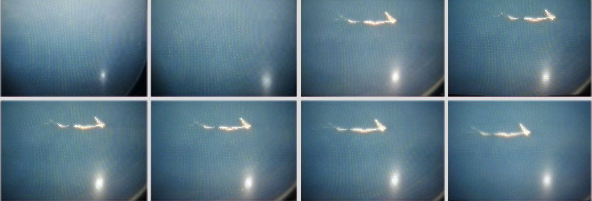Subsun
What is a Subsun?
A subsun is a fascinating atmospheric phenomenon that occurs when the sun's rays are reflected off millions of cloud crystals acting together as a giant mirror. It is the most common type of subhorizon halo and is often seen as a circular image of the sun, although it can become elongated or result in a lower sun pillar depending on the movement and tilt of the crystals. Plate crystals are typically responsible for producing subsuns, with rays reflecting externally off the uppermost horizontal face or internally from the lowermost.
The Formation of Subsuns
Subsuns form when sunlight interacts with thin cirrus clouds that contain plate crystals. These plate crystals are hexagonal in shape and act as mirrors, reflecting the sunlight back towards the observer. As the sunlight passes through these crystals, it undergoes refraction and reflection, creating the optical illusion of a subsun.
When the plate crystals are relatively stable and aligned, the subsun appears as a circular image of the sun. However, as the crystals wobble and tilt, the subsun can become elongated. In some cases, the elongation is significant enough to transform into a lower sun pillar. The movement of these crystals is influenced by various factors such as wind speed, atmospheric conditions, and the size of the crystals themselves.
Observing Subsuns
To observe a subsun, one must look downwards towards the horizon. Subsuns are typically seen below the actual position of the sun, hence the term "subhorizon halo." They are most commonly visible when there is a thin cirrus cloud cover, allowing for the reflection of sunlight off the plate crystals.
The appearance of a subsun can vary depending on the observer's location and the specific atmospheric conditions. Sometimes, the subsun may appear as a distinct circular image with well-defined edges. Other times, it may be more elongated or distorted due to the movement and tilt of the plate crystals.
The Beauty of Subsuns
Subsuns are not only scientifically intriguing but also visually captivating. When observed, they can create a stunning display of light and color in the sky. The reflection of sunlight off the cloud crystals produces a halo-like effect, adding a touch of ethereal beauty to the atmosphere.
In addition to the subsun itself, other atmospheric optical phenomena may accompany it, further enhancing the spectacle. These can include sun pillars, sun dogs, and even circumhorizontal arcs, depending on the specific conditions and the angle of sunlight interacting with the ice crystals.
Understanding Atmospheric Optics
Studying atmospheric optics, including phenomena like subsuns, allows scientists and researchers to gain a deeper understanding of the interactions between light and the atmosphere. By investigating the formation and behavior of subsuns, they can unravel the complexities of atmospheric conditions and the intricate processes that lead to the creation of these optical phenomena.
The study of atmospheric optics also has practical applications. It aids in weather prediction and helps improve our understanding of climate patterns. Additionally, it contributes to advancements in remote sensing technologies and satellite imagery, allowing for more accurate observations and measurements of Earth's atmosphere.
The Delight of Subsun Sightings
For sky enthusiasts and photographers alike, witnessing a subsun can be a thrilling experience. The fleeting nature of these optical phenomena adds an element of excitement and anticipation to their observation. Capturing the beauty of subsuns through photography enables individuals to share their awe-inspiring encounters with others and spread awareness about the wonders of the natural world.
As subsuns are relatively common compared to some other atmospheric optics phenomena, there is always a possibility of encountering one under the right conditions. By staying informed about the atmospheric conditions conducive to subsun formation and keeping an eye on the sky, one can increase their chances of experiencing this captivating spectacle.
In conclusion, subsuns are mesmerizing atmospheric phenomena that occur when sunlight reflects off cloud crystals, creating a mirror-like effect. These optical illusions can appear as circular images of the sun or become elongated and transform into lower sun pillars. Observing subsuns provides a unique opportunity to appreciate the beauty and complexity of atmospheric optics, while also contributing to scientific knowledge and inspiring a sense of wonder in those fortunate enough to witness them. So keep your eyes on the sky and embrace the possibility of encountering a subsun, adding a touch of magic to your day.

A bright subsun seen looking downwards from 11,000m over Italy, late afternoon 18th July 1995. The halo was intermittently visible over the southern and central parts of the country which was covered by a thin cirrus sheet. The halo elongated and contracted as the tilts of the plate crystal mirrors changed. Reflections from lakes and rivers shine through the cloud. Video- Les Cowley.

Subsun forming rays
The subsun is the most common subhorizon halo. It is a direct reflection of the sun from millions of cloud crystals acting together as a giant mirror. Plate crystals are the usual source. Rays can reflect externally off the uppermost horizontal face or internally from the lowermost.
The halo can be an almost circular image of the sun but it becomes elongated the more the crystals wobble and tilt until eventually a lower sun pillar results. We usually see something between these two extremes.
Note: this article has been automatically converted from the old site and may not appear as intended. You can find the original article here.
Reference Atmospheric Optics
If you use any of the definitions, information, or data presented on Atmospheric Optics, please copy the link or reference below to properly credit us as the reference source. Thank you!
-
<a href="https://atoptics.co.uk/blog/subsun/">Subsun</a>
-
"Subsun". Atmospheric Optics. Accessed on December 21, 2024. https://atoptics.co.uk/blog/subsun/.
-
"Subsun". Atmospheric Optics, https://atoptics.co.uk/blog/subsun/. Accessed 21 December, 2024
-
Subsun. Atmospheric Optics. Retrieved from https://atoptics.co.uk/blog/subsun/.